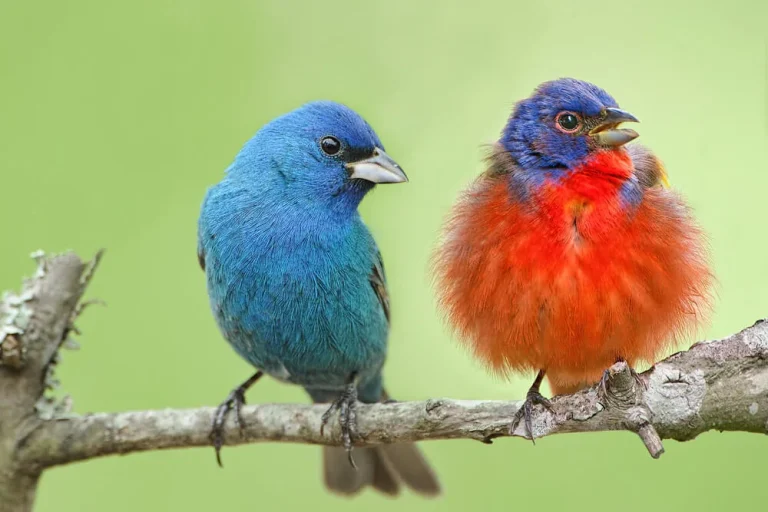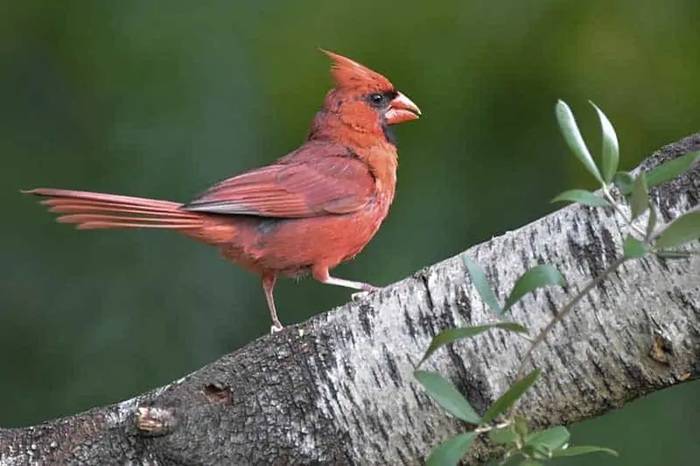North Carolina is a mountain state, woodlands state, sea state, and marsh state. No wonder, then, that the state is full of an incredible array of birds. Birders never tire of asking the same question: what NC birds can be seen throughout the state? Hundreds, the reply.
From yard chickadees and cardinals to ospreys by the coast, NC birds bring color and melody to every corner of the state. Some stay year-round. Others stop by. All contribute to the state’s appearance and sound.
This book takes you along with North Carolina’s birds. You’ll get to know the backyard regulars, mountain inhabitants, coastal migrants, and the occasional straggler. You’ll find out how to watch them, why North Carolina is bird watcher’s heaven, and how you can be part of what makes their backyard heaven.
NC Birds in Backyards
Northern Cardinal
North Carolina state bird. Male is a deep red. The female is dull reddish brown. Cardinals visit backyards and parks daily. Cardinals consume sunflower, safflower, and fruits. Whistling cardinal’s song at dawn.
Carolina Chickadee
Small and bold and curious. Black cap on top of head, white cheeks, gray back. Chickadees are sociable and frequent daily visitors. Chickadees love seeds and suet.
Tufted Titmouse
Gray back, white belly, and sunny head. These NC birds fly into yards and woods every day. Zipping in, grabbing a seed, and zipping out again.
Eastern Bluebird
Sign of good luck. Colorfully striped backs and orange chests on males. Females are subdued but equally as lovely. Bluebirds take homes and dine on mealworms, berries, and bugs.
American Goldfinch
Flash of yellow in summer, olive in winter. Find their way to sunflower patches and thistle feeders.
NC Birds in the Mountains
Specialized habitats in Blue Ridge and Smoky Mountains.
- Scarlet Tanager: Black wings, glossy red male. Wood birds of summer.
- Black-throated Blue Warbler: Grayish-blue and black. Migrant, passerby.
- Ruffed Grouse: Hidden on forest floors. Elusive drumming show.
- Broad-winged Hawk: Glides high along ridges in huge migrating flocks or “kettles.”
- Pileated Woodpecker: Crow-sized red-crested woodpecker.
NC mountain birding is optimum in spring and summer months when migrants have arrived to breed.
NC Coastal Birds
Outer Banks and the coast are famous for a variety of birds.
- Brown Pelican: Large sea bird head diving into sea looking for fish.
- Osprey: Fish-hawking hawk with well-documented breeding on water towers and other skyscrapers.
- Royal Tern: Orange-billed thin seabird. Colonies on the beach.
- Black Skimmer: Snaps lower bill long and cuts surface of water for fish.
- Clapper Rail: Creeping Swamp dweller, whose voice is heard more than itself.
Pea Island refuges are wintering grounds for geese and ducks. They blacken morning and evening skies with thousands.
NC Birds in Wetlands
North Carolina wetlands shelter:
- Great Egret: White wader with yellow bill.
- Great Blue Heron: Largest of the North American herons.
- Wood Duck: Painted and frequently nesting in tree cavities.
- Prothonotary Warbler: Sweet yellow wet wood warbler.
- Red-winged Blackbird: Red and yellow shoulder patches on singing male.
Wetlands are invaluable to NC residents and migrant birds.
Unseasonable and Unusual NC Birds
A few NC birds are rare but a delight to spot.
- Snow Bunting: Rare winter visitor to coastal sand dunes.
- Peregrine Falcon: Once endangered, now beginning to return on mountain cliffs.
- Swallow-tailed Kite: Rare summer raptor with notched tail, gliding effortlessly.
- Painted Bunting: Colorful finch, uncommon but more so close to coast.
- Tundra Swan: Thousands spend winter months in NC coastal marshes.
Why North Carolina Is a Bird Paradise
North Carolina is geographically mixed. Mountain, piedmont, coastal plains, and barrier islands with a diversity of bird life. Migrations come through NC, i.e., warblers in spring and ducks in winter. NC bird watching is some of the finest on the East Coast.
Best NC Bird Watching Sites
Mountains
- Blue Ridge Parkway
- Great Smoky Mountains National Park
- Mount Mitchell
Piedmont
- Jordan Lake
- Umstead State Park
- Greensboro Arboretum
Coast and Wetlands
- Outer Banks
- Pea Island National Wildlife Refuge
- Cape Hatteras
- Lake Mattamuskeet
Some NC birds will be encouraged to visit all the areas at least once annually.
Feeding NC Birds in Your Yard
More birds day by day? Feeding stations can assist.
- Seed Feeders: Cardinels, chickadees, titmice, and finches are drawn in.
- Suet Feeders: Woodpeckers, wrens, and nuthatches are drawn in.
- Nectar Feeders: Invite summer hummingbirds.
- Fruit and Jelly: Invite orioles and catbirds.
Keep feeders clean to keep disease off. Provide fresh water in baths year-round.
Table: Popular NC Birds and What They Feed On
| Bird Species | Physical Description | Favorite Foods |
| Northern Cardinal | Male red, female brown | Sunflower, safflower |
| Carolina Chickadee | Black cap, white cheeks | Seeds, suet |
| Eastern Bluebird | Blue back, orange breast | Mealworms, berries |
| American Goldfinch | Summer yellow | Sunflower, thistle |
| Red-winged Blackbird | Black with red spots | Seeds, insects |
| Brown Pelican | Large, gray-brown | Fish |
| Great Blue Heron | Gray-blue, tall | Fish, frogs |
| Wood Duck | Brightly colored male plumage | Seeds, aquatic plants |
Conservation of NC Birds
NC birds are at risk from climate change, pollution, and loss of habitat. Wetlands are vanishing. Forests are breaking up. Beaches are being worn away. Conservation is great stuff, though. Refuges for wildlife, conservation forests, and citizen science rescue birds.
Birders are helping out by reporting, planting native gardens, and donating money to conservation organizations. All feeders, trees, and clean sources of water are rescuing NC birds.
Fun Facts About NC Birds
- The northern cardinal was declared state bird of NC in 1943.
- More than 475 bird species are included in the state’s listing.
- Tundra swans migrate more than 3,000 miles from Arctic tundra to NC marshes.
- Painted buntings are also called “nonpareils,” i.e., “without equal” in French.
- NC’s Outer Banks is a top Atlantic Flyway stop for migration.
FAQs About NC Birds
Q1. What is the state bird of North Carolina?
Northern cardinal, chosen by look and sound.
Q2. How many NC species of birds?
Over 475 state-wide.
Q3. Where do the most interesting beach birds of NC live?
Outer Banks and Pea Island National Wildlife Refuge.
Q4. Are hummingbirds year-round residents in NC?
Ruby-throated hummingbirds live in NC spring and summer and migrate south for winter.
Q5. Can I attract NC birds to my garden?
Yes. Bird feeders, bird baths, and native plants attract many species.
North Carolina is a bird state. From the mountain tanagers to the seacoast pelicans, from the yard cardinals to the winter swans, the state is full of richness of wings and song.
So what NC birds do you see? It’s a huge, huge list of surprises. Cardinals, chickadees, titmice, finches, grosbeaks, woodpeckers, herons, pelicans, and lots more. They all contribute to the image.
For the bird enthusiast, NC is an Aladdin’s cave. From your feeder chickadee to the aerial V of tundra swans bringing the sky back to fullness with their company, every second is a blessing. Keeping such birds alive guarantees the coming generations to witness the glory of NC bird treasures.




